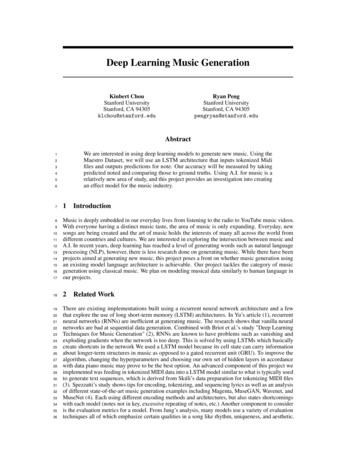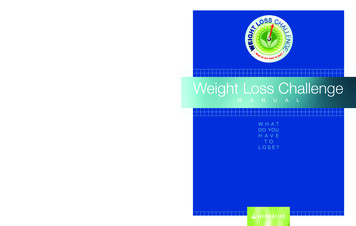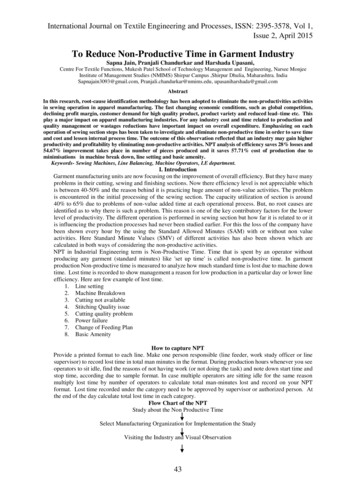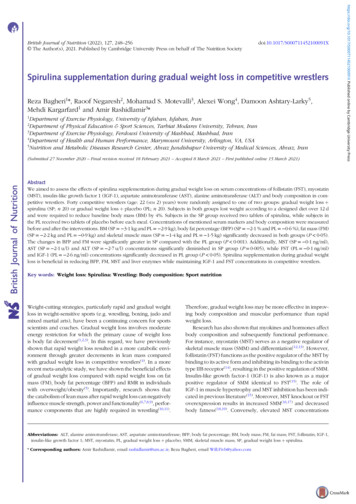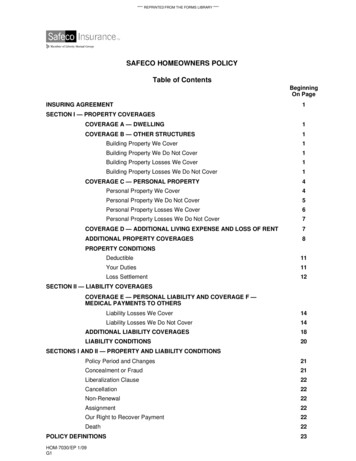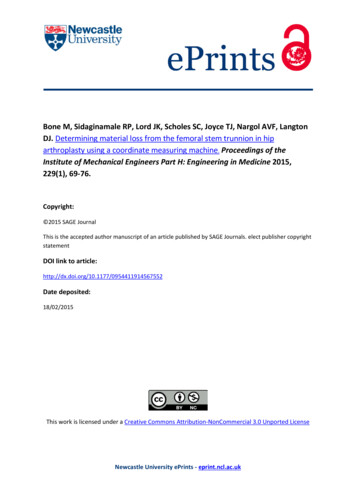
Transcription
Bone M, Sidaginamale RP, Lord JK, Scholes SC, Joyce TJ, Nargol AVF, LangtonDJ. Determining material loss from the femoral stem trunnion in hiparthroplasty using a coordinate measuring machine. Proceedings of theInstitute of Mechanical Engineers Part H: Engineering in Medicine 2015,229(1), 69-76.Copyright: 2015 SAGE JournalThis is the accepted author manuscript of an article published by SAGE Journals. elect publisher copyrightstatementDOI link to Date deposited:18/02/2015This work is licensed under a Creative Commons Attribution-NonCommercial 3.0 Unported LicenseNewcastle University ePrints - eprint.ncl.ac.uk
Determining material loss from the femoral stem trunnionAbstractIn contrast to the articulating and taper surfaces of failed total hip replacements,volumetric wear analysis of trunnions is not routinely performed. Metal wear particlesfrom the trunnion may contribute not only to the failures of metal-on-metal total hipreplacements, but all hip replacements utilising metal trunnions.A validation study was performed with material removed in stages from the trunnionsof an Exeter V40 stem, a Corail stem and an Accolade stem to simulate differentmagnitudes of wear. The material loss from the trunnions was measured bothvolumetrically with a coordinate measuring machine and gravimetrically with a highprecision balance. A cohort of 28 ex vivo trunnions was also measured using thecoordinate measuring machine.The maximum error between the two methods was found to be 0.13 mm³. This resultwas comparable with the co-ordinate measuring machine method for the tapersurface (0.2 mm³). The ex vivo trunnions had a median wear volume of 0.14 mm³(range 0.04 – 0.28 mm³).This is the first study to determine the accuracy of volumetric wear measurements oftrunnions by comparing against gravimetric measurements. Volumetric wear analysis1
Determining material loss from the femoral stem trunnionof trunnions may provide additional insights into failures of modular total hipprostheses, and will be performed routinely at our centre.Keywords: Explant analysis, trunnion, volumetric wear, coordinate measuring machine,validation1. IntroductionWear debris is known to result in negative host responses, with metal wear particlesassociated with adverse reaction to metal debris [ARMD] failures and includingpseudotumours [1] [2], whilst polyethylene wear is predominantly associated withosteolysis [3]. It is therefore desirable to reduce wear in prostheses, regardless ofmaterial, to improve their long term performance.High failure rates of metal on metal [MoM] total hip replacements [THR] comparedwith MoM resurfacings have implicated wear of the taper junction as a potential causeof failure. Data from the 2014 National Joint registry has shown that the number ofrevisions per 1000 patient years for ARMD is higher for THR prostheses (7.2) comparedwith MoM resurfacing prostheses (3.9) [4].2
Determining material loss from the femoral stem trunnionSubsequent volumetric wear analysis has found that the femoral head taper cancontribute a significant percentage of the total wear volume [54]. Other studies havereported significant damage to the taper, attributing it to corrosion [65] [76] [78],mechanical wear [89] [45] or as a combination of both [1] [109] [110] [121] [132].Whilst volumetric wear analysis of the taper is routinely performed, this is not the casewith femoral stem trunnions. Note that volumetric wear in MoM resurfacingprostheses is from the bearing surface only, whilst for MoM THR prostheses wear canoccur at both the bearing surfaces and the taper trunnion junction.Retrieval studies examining trunnions have been restricted to visual grading of frettingand corrosion [134] [145], chemical analysis [156] and profilometry [167], with onlyone study reporting wear volumes for two trunnions [98]. There has been, to theauthors’ best knowledge, no study in the literature, which has validated a method forquantifying the volumetric wear of the trunnion surface. Langton et al. and Blunt et al.have previously noted that gravimetric measurements are the most accurate methodfor quantifying material loss due to wear [18] [19]. against the gold standard ofgravimetric measurements.Coordinate measuring machines (CMM) have been used extensively to quantifyvolumetric wear of prostheses [2017] [45] [1821] [1922] [230]. We have previously3
Determining material loss from the femoral stem trunnionpublished the results of several validation studies comparing volumetric results from aMitutoyo Legex 322 (Mitutoyo UK Ltd, West Point Business Park, Andover, Hampshire,UK) CMM against gravimetric measurements [20]. Lord et al. (2011) presented amethod for measuring the wear of articulating surfaces of MoM hip components withthe method found to be accurate to within 0.5 mm³ [2017]. Langton et al. reported asimilar method used to measure DePuy ASR and Pinnacle tapers, with an accuracy of0.2 mm³ [54].This paper describes a method for the measurement of volumetric wear from femoralstem trunnions using a CMM. The method is validated against the “gold standard” ofgravimetric measurements to determine its the accuracy of this technique. A cohort of28 retrieved femoral stem trunnions were then analysed using this method to provideclinical context.2. MethodsValidationThe study was performed to determine the accuracy of volumetric wearmeasurements involving total hip replacement (THR) stems. Three femoral stemtrunnions were used for measurements: one Exeter V40 femoral stem, one Corail stemand one Accolade stem. These stems were obtained from hospital stock as they had4
Determining material loss from the femoral stem trunnionrecently breached the dates by which they should have been implanted. The stemswere received in their unopened, sterile packaging. The Exeter stem is the mostcommonly used cemented stem, whilst the Corail and the Accolade are the two mostcommonly used uncemented stems according to data from the National Joint Registry2013 for England, Wales and Northern Ireland [214]. The Exeter V40 stem was used in66% of all cemented hip procedures, with the Corail stem accounting for 46% of allcementless hip procedures [241]. Both the Exeter V40 and the Corail stems are ODEP[Orthopaedic Data Evaluation Panel] 10A rated, whilst the Accolade is ODEP 3B rated.ODEP 10A rating indicates that there is strong evidence that the prosthesis meets theNational Institute for Health and Care Excellence [NICE] guidelines at 10 years [252].ODEP 3B rating indicates that a small cohort has demonstrated a revision rate of lessthan 3% at three years [252]. The stems were sectioned at the neck junction belowthe trunnion to enable them to fit within the balance for gravimetric measurements(figure 1).2.1.Testing procedureGravimetric measurements were performed using a Kern ACJ320-4M (Kern and SohnGmbH, Ziegelei, Ballingen, Germany) balance with a readability sensitivity of 0.1 mg.5
Determining material loss from the femoral stem trunnionFor the volumetric measurements a Mitutoyo Legex 322 CMM was used with a 5 mmdiameter ruby stylus. The manufacturer claimed measuring accuracy for the Legex 322was 0.8 µm.A standard measurement procedure was established to ensure consistency. Coordinate measurement machine and gravimetric measurements were performed bydifferent authors as to blind the results. In order to avoid accidental material lossthrough scratching or other contact, gravimetric testing was always performed firstwith CMM measurements performed afterwards. For each stage of wear a minimumof four gravimetric and three CMM measurements were taken. Trunnion wear wassimulated by removing increasing amounts of material using P240 grade sand paper.Sandpaper was chosen utilised in order to allow controlled removal. The trunnion wasthen cleaned using compressed air to ensure all wear particles had been removed.Gravimetric and volumetric measurements were then performed. More material wasthen removed in stages to simulate increasing amounts of wear and themeasurements repeated for the different stages of material loss. A total of four“wear” stages were tested, including the unworn stage.Once all measurements were completed the values obtained from the gravimetrictests were converted into volumes. The median wear volume for each stage of wear6
Determining material loss from the femoral stem trunnionwas then calculated and compared with the median wear values from the CMM. Forthe Exeter V40 the density of 316L medical grade stainless steel (8.00 g/cm³) was used.For the Corail the density of TiAl6V4 titanium alloy (4.42 g/cm³) [236] was used. Forthe Accolade the density of Ti-12Mo-6Zr-2Fe titanium alloy (5.00 g/cm³) was used. Forthe three samples a small ring of unworn surface approximately two millimetres inwidth was consistently left at the top of the trunnion to represent unworn surface.However for the final wear stage on the Accolade stem material was removed from theunworn surface to determine how this affected the CMM measurement accuracy.2.2.CMM trunnion measurementsCustomised programmes were written using the Mitutoyo “MCOSMOS” software tomeasure the trunnion surfaces. As with the bearing surfaces identification of theoriginal surface is vital in order to accurately determine the volumetric wear [1824].The CMM programme requires the user to enter three variables in order to measurethe trunnion. These variables are referenced against the coordinate system (figure 2).The first variable is the ‘length’, representing the total height of the trunnion overwhich measurements are to be taken. The other two values correspond to the lowerand upper height of the circumferential band of unworn surface. These values were7
Determining material loss from the femoral stem trunniondetermined by analysing the trunnion from base to tip using a Mitutoyo surftest sj400profilometer, providing a visual representation of the surface. The area with the mostsimilar mean roughness average and peak to valley height values to those of ameasured unused and unworn specimen was then used as the unworn Z area.Once the trunnion location has been determined the programme works iteratively intwo stages. The initial stage generated a perfect theoretical cone representing theoriginal perfect unworn surface. The second stage measured the entire surface andcompares the data points with the perfect cone to determine any deviations, whichrepresent the volumetric wear. This is represented in flowchart format in figure 3.2.2.1. Trunnion coordinate systemAn initial “centre point” was taken manually by the user on the flat top of the trunnion(the smaller end of the truncated cone) to determine the trunnion’s position. Usingthis point the CMM then automatically took three circumferential traces on top of thetrunnion to determine an initial XY plane from which the Z axis zero value is referenced(figure 2). The initial Z axis (the cone axis) was derived by the CMM as the axis throughthe centre point of these initial circular traces.8
Determining material loss from the femoral stem trunnionFive equispaced circumferential traces were taken by the CMM around the trunnion atvarious heights, beginning at the base and working towards the tip. Four linear traceswere then taken over the full length of the trunnion at 90 intervals around thecircumference. These scans provided more data points from which to derive the Zaxis.2.2.2. Stage one: Theoretical cone generationFor stage one a series of 20 equispaced vertical linear traces were then taken aroundthe circumference over the area initially specified as unworn by the user. Thestraightness of each of these 20 traces was calculated by the CMM. The CMMaccepted each trace if it was found to have a straightness value of less than 0.0025mm(figure 43). Straightness is defined as the distance between two parallel planestouching and enclosing the data points at the minimum distance to each other [257].Any of the twenty traces with straightness values greater than 0.0025mm wererejected. The accepted traces were then used to generate a perfect theoretical cone.A minimum of five traces were required to continue the scans. If this was not achievedthe generated cone was not of sufficient precision to continue and the user must hadto reassess the location from which to best determine the unworn area.9
Determining material loss from the femoral stem trunnionThe Z axis was defined as the principle axis of the theoretical cone described above,with the data points from stage two referenced in relation to this axis. The angle ofthe cone was used during the MATLAB calculation of the wear volume.From the theoretical cone described above, the Z axis of the coordinate system wasestablished and the definitive contour scans proceed. The angle of this cone was usedduring the MATLAB calculation of the wear volume. The principle axis of this coneacted as the Z axis to reference the subsequent data points measured during thecontour scans (stage two).2.2.3. Stage two: Contour measurementOnce the initial stage was completed a series of 20 full length, equispaced verticallinear “contour scans” were then performed around the trunnion using a point pitch of0.3 mm from the base to the tip. The Exeter stem had a smoother surface finish thanthat of the grooved Corail stem, which was designed for the use of ceramic heads.2.2.4. Data processingTo process the ASCII data files produced by the CMM a customised MATLABprogramme was developed. Using the trunnion angle provided by the CMM10
Determining material loss from the femoral stem trunnionprogramme, MATLAB was then able to produce a three dimensional heat mapdetailing the wear on the surface. It also provided a maximum linear wear depth andwear volume. In addition to the trunnion angle the MATLAB programme required theuser to input a height value corresponding to the location of the identified unwornregion. If the trunnion was projected from a worn region then spurious data points arecreated and the wear calculation was inaccurateted inaccurately.Ex vivo cohortA cohort of 28 DePuy Corail femoral stems was obtained following revision surgery.The trunnions were cleaned using acetone and lint-free cloth to remove surfacedeposits. The majority of the revisions were due to adverse reaction to metal debris(ARMD) failure, with a minority revised solely due to loosening of the femoral stems.Of the 28 femoral stems 23 were paired with a metal femoral head and the remainingfive paired with a ceramic femoral head. The location of unworn sections of alltrunnions was determined visually and using a profilometer. Once this was completedthe trunnions were measured using the CMM.In THR arthroplasties, which involve a modular neck connection, the head is pressfitted on to the stem. Successful engagement depends on a close match between thecone angles of the trunnion and the taper. However due to the manufacturing11
Determining material loss from the femoral stem trunnionprocess, identical angles for both components and thus direct contact over the entirelength of the trunnion is nearly impossible [112]. Therefore the taper and trunnion aredesigned so that engagement occurs preferentially at either the base or tip of thetrunnion depending on the relative angle between the two [121]. Here, tip refers tothe smaller end of the truncated cone, whilst base refers to the larger end of the cone.As a result the end (base or tip) of the trunnion not in contact with the taper washypothesised to be relatively undamaged.3. Results3.1.Validation resultsMedian volumetric and gravimetric results for the three new samples are shown infigure 45. For the unworn stage (stage 0) the Corail trunnion had a higher measuredCMM wear volume of 0.13 mm³ compared with the V40 and the Accolade, both at 0.05mm³. The maximum error between individual measurements for all other stages was 0.02 mm³ for the Corail and 0.03 mm³ for both the V40 and the Accolade (as shownby the error bars in figure 54). For the final wear stage on the Accolade stem, wherematerial was removed from the unworn surface, the CMM was unable to obtain anaccurate volumetric measurement. Figure 6 shows a Bland Altman plot of all theresults, whilst Figure 7 shows the correlation between CMM and gravimetric12
Determining material loss from the femoral stem trunnionmeasurements for the three stems. The 95% confidence intervals are also presented.Figure 5 8 shows the wear maps generated by MATLAB with the theoretical coneprojected from one millimetre below the top of the trunnion.3.2.Retrieval analysisA median wear volume of 0.14 mm³ (range 0.04 – 0.28 mm³) was measured for the 28explanted trunnions. Twenty seven of the trunnions were found to have lost less than0.2 mm³, with figure 96 showing a typical wear map. For the more heavily worntrunnions the wear was predominantly located at the base of the trunnion, whilst thetip was relatively unworn. In several cases the surgical retrieval process causeddamage to the base of the trunnion resulting in it “flaring” out at two points locatedapproximately 180 apart from each other.4. DiscussionThis paper describes a method for measuring the volumetric wear of retrieved femoralstem trunnions. The maximum error was 0.13 mm³ with the error decreasing withincreasing wear volumes. In the unworn state the Corail stem may have had a greater13
Determining material loss from the femoral stem trunnionmeasurement error than the other two stems due to the grooved pattern on thesurface. The maximum error was comparable to that of the taper (0.2 mm³) [45]. Tothe authors’ best knowledge this is the first study to validate a method for calculatingvolumetric wear for the trunnion against gravimetric measurements. In addition this isthe largest cohort of retrieved femoral stem trunnions to undergo volumetric wearanalysis that has been reported in the literature.The ex vivo titanium alloy Corail stem trunnions had lower surface wear comparedwith wear volumes for articulating and taper surfaces reported in the literature [1720][54]. The study by Langton et al reported median wear volumes in excess of 2 mm³from the taper surfaces of a cohort of 111 MoM femoral heads [20]. This was a factorof ten greater than the wear volumes measured for the trunnions in the present study.To the authors’ best knowledge there is only one other study offering volumetric wearvalues of retrieved trunnions. Bishop et al. examined two retrieved 12/14 titaniumtrunnions using a coordinate measuring machine reporting wear volumes of 0.020mm³ and 0.035 mm³ [98]. These values were significantly lower than values reportedfor the respective taper surfaces (8.1 and 2.6 mm³) [98]. This is exactly our ownexperience. It may seem counterintuitive as that the apparently softer titanium stemtrunnion showed lower wear than the apparently harder cobalt chromium (CoCr) alloyof the femoral head taper.14
Determining material loss from the femoral stem trunnionMoharrami et al. provided a potential explanation to this apparent paradox bymeasuring the relative hardness values of titanium stems and CoCr femoral headtapers [286]. The study found that titanium stems oxidised preferentially to the CoCrsurfaces, significantly increasing the surface hardness [286]. The harder oxidisedtitanium stems were then able to damage the un-oxidised CoCr alloys, resulting inwear of the head taper in preference to the trunnion [286].There were limitations to this study. The first of these was the small number oftrunnions tested. Ideally testing would have included multiple samples from a widervariety of manufacturers; however obtaining unused stems from hospital stock provedextremely challenging. Therefore the most commonly implanted cemented anduncemented stems were tested [214]. The measurement error of 0.13 mm³ is directlycomparable to that of the taper surface (0.2 mm³) [45]. In addition the CMMmeasurements had a high level of repeatability with a maximum difference of 0.03mm³ between individual measurements, demonstrating that this method is bothaccurate and reproducible.The second limitation was that the location of the wear was known in all but one case,allowing an unworn section of the trunnion to be selected for the measurement. Forthe Accolade where material was removed from the unworn surface, the CMM was15
Determining material loss from the femoral stem trunnionunable to accurately calculate the wear volume. However in THRs the taper trunnionangles are designed so that engagement occurs primarily at the tip or base of thetrunnion, leaving a relatively undamaged section where no contact occurred [121].The cohort of ex vivo prostheses analysed followed this trend supporting the validationmethod of using a profilometer to identify the undamaged surface.As a result of this study ex vivo volumetric wear measurements will be performed onall retrieved femoral stem trunnions received at our research centre. Further studieswill then examine the relationship between trunnion and taper wear.Conflict of interestD. J. Langton is director of PXD. PXD has received money though medicolegalconsultations concerning failed metal-on-metal hips; as has A. V. F. Nargol. NewcastleUniversity has also received money through medicoloegal litigation on the samesubject. The salaries of S. C. Scholes and M. C. Bone have been partially funded fromthis money. R. P. Sidaginamale M. C. Bone and J. K. Lord have received consulting feesfrom PXD medical in the last 36 months.Funding statement16
Determining material loss from the femoral stem trunnionThis research received no specific grant from any funding agency in the public,commercial, or not-for-profit sectors.References1.Cook RB, Bolland BJ, Wharton JA, et al. Pseudotumour formation due totribocorrosion at the taper interface of large diameter metal on polymermodular total hip replacements. J Arthroplasty 2013; 28: 1430-1436.2.Langton DJ, Joyce TJ, Jameson SS, et al. Adverse reaction to metal debrisfollowing hip resurfacing: the influence of component type, orientation andvolumetric wear. J Bone Joint Surg Br 2011; 93: 164-171.3.Harris WH. The problem is osteolysis. Clin Orthop Relat Res 1995; 311: 46-53.4.National Joint Registry. National Joint Registry 11th Annual efault.aspx (accessed 11 December2014)5.Langton DJ, Sidaginamale R, Lord JK, et al. Taper junction failure in largediameter metal-on-metal bearings. Bone Joint Res 2012; 1: 56-63.65.Atwood SA, Patten EW, Bozic KJ, et al. Corrosion-induced fracture of a doublemodular hip prosthesis a case report. J Bone Joint Surg Am 2010; 92: 15221525.17
Determining material loss from the femoral stem trunnion76.Fricka KB, Ho H, Peace WJ, et al. Metal-on-metal local tissue reaction isassociated with corrosion of the head taper junction. J Arthroplasty 2012; 27:26-3187.Matthies AK, Racasan R, Bills P, et al. Corrosion is the main mechanism ofmaterial loss at the taper junction of large head metal on metal hipreplacements. Bone Joint J 2013; 95: 13.98.Bishop N, Witt F, Pourzal R, et al. Wear patterns of taper connections inretrieved large diameter metal-on-metal bearings. J Orthop Res 2013; 31: 11161122109.Dyrkacz RM, Brandt JM, Ojo OA, et al. The Influence of Head Size on Corrosionand Fretting Behaviour at the Head-Neck Interface of Artificial Hip Joints. JArthroplasty 2013; 28: 1036-1040110.Kop AM and Swarts E. Corrosion of a Hip Stem With a Modular Neck TaperJunction: A Retrieval Study of 16 Cases. J Arthroplasty 2009; 24: 1019-1023121.Preuss R, Haeussler KL, Flohr M, et al. Fretting Corrosion and Trunnion Wear—Is it Also a Problem for Sleeved Ceramic Heads? Semin Arthroplasty, 2012; 23:251-25718
Determining material loss from the femoral stem trunnion132.Rodrigues DC, Urban RM, Jacobs JJ, et al. In vivo severe corrosion and hydrogenembrittlement of retrieved modular body titanium alloy hip-implants. J BiomedMater Res B Appl Biomater 2009; 88: 206-219143.Huot Carlson JC, van Citters DW, Currier JH, et al. Femoral stem fracture and invivo corrosion of retrieved modular femoral hips. J Arthroplasty 2012; 27: 13891396154.Kurtz SM, Kocagoz SB, Hanzlik JA, et al. Do ceramic femoral heads reduce taperfretting corrosion in hip arthroplasty? A retrieval study. Clin Orthop Relat Res2013; 471: 3270-3282165.Bisseling P, Tan T, Lu Z, et al. The absence of a metal-on-metal bearing does notpreclude the formation of a destructive pseudotumor in the hip—a case report.Acta Orthop 2013; 84: 437-441176.Kocagöz SB, Underwood RJ, Sivan S, et al. Does taper angle clearance influencefretting and corrosion damage at the head–stem interface? A matched cohortretrieval study. Semin Arthroplasty 2013; 24: 246-254187.Langton DJ, Sidaginamale RP, Holland JP, et al. Practical considerations forvolumetric wear analysis of explanted hip arthroplasties. Bone Joint Res 2014;3: 60-68.19
Determining material loss from the femoral stem trunnion19.Blunt LA, Bills PJ, Jiang XQ, Chakrabarty G. Improvement in the assessment ofwear of total knee replacements using coordinate-measuring machinetechniques. Proc Inst Mech Eng H 2008; 222: 309-31820.Lord JK, Langton DJ, Nargol AVF, et al. Volumetric wear assessment of failedmetal-on-metal hip resurfacing prostheses. Wear 2011; 272: 79-87.2118. Knowlton CB and Wimmer MA. An autonomous mathematical reconstructionto effectively measure volume loss on retrieved polyethylene tibial inserts. JBiomed Mater Res B Appl Biomater 2013; 101: 449-457.2219. Stoner KE, Nassif NA, Wright TM, et al. Laser scanning as a useful tool inimplant retrieval analysis: a demonstration using rotating platform and fixedbearing tibial inserts. J Arthroplasty 2013; 28: 152-156.230.Witzleb WC, Hanisch U, Ziegler J, et al. In vivo wear rate of the Birmingham HipResurfacing arthroplasty. A review of 10 retrieved components. J Arthroplasty2009; 24: 951-956.241.National Joint Registry. National Joint Registry 10th Annual Report. 2013;www.njrcentre.org.uk/njrcentre/default.aspx (accessed 10 June 2014)252.Orthopaedic Data Evaluation Panel. Product Ratings 2013; www.odep.org.uk263.Ratner BD, Hoffman AS, Schoen FJ, et al. An introduction to materials inmedicine. 2004: Elsevier Academic Press.20
Determining material loss from the femoral stem trunnion24.Langton DJ, Sidaginamale RP, Holland JP, et al. Practical considerations forvolumetric wear analysis of explanted hip arthroplasties. Bone Joint Res 2014;3: 60-68.275.Suga N and Rollings P. Mitutoyo metrology handbook. Mitutoyo 2007.286.Moharrami N, Langton DJ, Sayginer O, et al. Why does titanium alloy wearcobalt chrome alloy despite lower bulk hardness: A nanoindentation study?Thin Solid Films 2013; 549: 79-86.Figure 1: Photo of sectioned trunnions used in testingFigure 2: Coordinate system set up for a trunnion. NB the height of the trunnion ismeasured negatively in accordance with the coordinate systemFigure 3: Flow chart for the trunnion measurement process. Green indicates the userinput, red indicates CMM measurements stage one, blue indicates measurement stagetwo and purple indicates MATLAB processes21
Determining material loss from the femoral stem trunnionFigure 4: Unworn Corail linear trace. NB the green region indicates the tolerance zoneFigure 54: CMM vs gravimetric result comparison for the V40, Corail and AccoladetrunnionsFigure 65: Bland Altman plot of the validation results. Note that LLA is the lower levelof acceptance, whilst ULA is the upper level of acceptanceFigure 7: Graph showing the CMM and gravimetric volumetric wear results for A) V40stem B) Corail stem C) Accolade stem. The 95% confidence intervals are also presentedFigure 8: CMM wear maps for the Corail trunnion showing increasing wear from A toD. NB green indicated unworn surface; red is worn surfaceFigure 96: CMM wear map showing minimal wear on a retrieved trunnion22
66% of all cemented hip procedures, with the Corail stem accounting for 46% of all cementless hip procedures [241]. Both the Exeter V40 and the Corail stems are ODEP [Orthopaedic Data Evaluation Panel] 10A rated, whilst the Accolade is ODEP 3B rated. ODEP 10A rating indicates that there is strong evidence that the prosthesis meets the





